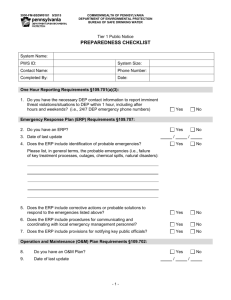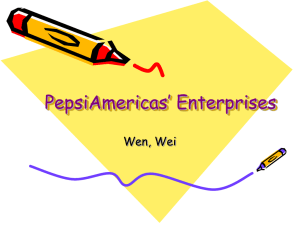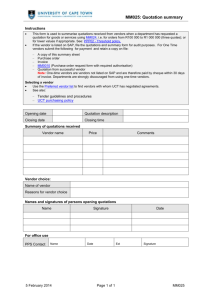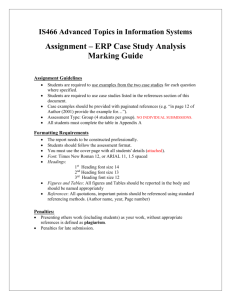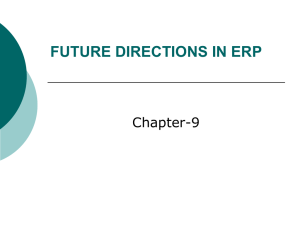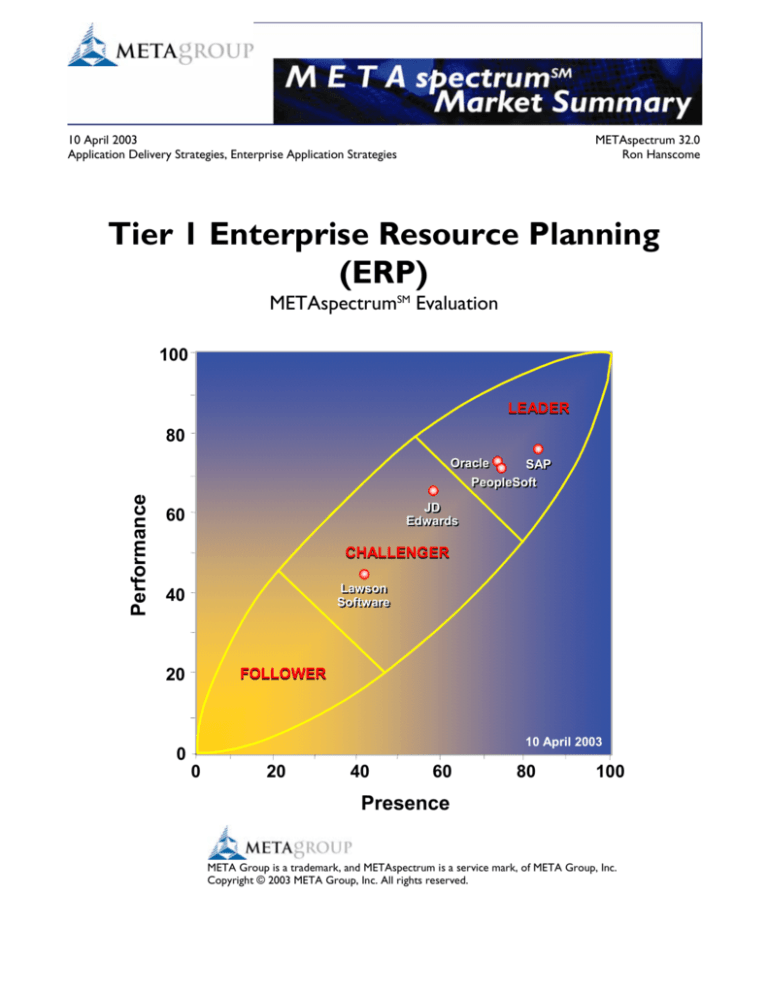
10 April 2003
Application Delivery Strategies, Enterprise Application Strategies
METAspectrum 32.0
Ron Hanscome
Tier 1 Enterprise Resource Planning
(ERP)
METAspectrumSM Evaluation
100
LEADER
80
Performance
Oracle
SAP
PeopleSoft
JD
Edwards
60
CHALLENGER
Lawson
Software
40
20
0
FOLLOWER
10 April 2003
0
20
40
60
80
100
Presence
META Group is a trademark, and METAspectrum is a service mark, of META Group, Inc.
Copyright © 2003 META Group, Inc. All rights reserved.
Market Overview
Market Definition
META Group defines ERP as a suite of enterprise business applications including, at a minimum, financial and human resources
applications and at least one of the following: manufacturing, supply chain (SCM), or customer relationship management
(CRM). ERP solutions should be capable of satisfying at least 75% of the overall business application requirements for target
customers ($500M+ in annual revenues). ERP application functionality is mission-critical, and solutions are therefore regarded
as core IT investments. This market reached $15B globally in 2002 and is growing at 12%-15% annually.
Market Forecast
During 2003/04, reduced spending on new ERP projects by Global 2000 (G2000) firms will cause Tier 1 ERP vendors to focus
on selling additional functionality to existing G2000 customers, further penetrating the small and medium business (SMB)
market, developing more vertical extensions, and buttressing their technology infrastructure. During 2004/05, vendor viability
concerns will drive SMB ERP market consolidation as these vendors become increasingly threatened by Tier 1 vendors and
Microsoft. By 2005/06, Tier 1 ERP vendors will leverage their application breadth and component architectures to significantly
reduce application complexity, along with associated implementation cost and time. G2000 activity will increase in 2007, as
firms look to replace ERP infrastructures installed before 2000.
Key Findings
The Tier 1 ERP market is mature and concentrated, and the five vendors in this analysis — JD Edwards, Lawson, Oracle,
PeopleSoft, and SAP — account for a large percentage of the investment (more than 80%). Because ERP purchases usually
represent 10+ year commitments to application architecture and supporting infrastructure, a track record of longevity,
consistent performance, and market leadership is crucial. Presence and performance criteria are thus equally weighted for this
market. Although three of the vendors are large (with annual revenues in excess of $2B), size does not guarantee high
performance, and the smaller vendors often perform at levels close to the market leaders for specific criteria. Ranking vendors
in this market is complex, because application functionality must be compared to that of best-of-breed vendors (e.g., Siebel for
CRM, i2 for SCM), while the rest of the performance and presence criteria must be evaluated relative to the ERP vendor pool.
Leaders
Tier 1 ERP leaders — SAP, Oracle, and PeopleSoft — demonstrate an ability to both define a vision/strategy for ERP and
execute against it globally across a wide range of industries. Product breadth and depth, marketing prowess, and geographic
coverage are critical factors, as is the robustness of the technology platform (core architecture, integration, and application
management), because firms count on these applications to run mission-critical business processes.
Challengers
Tier 1 ERP challengers — JD Edwards and Lawson — are stable, financially successful firms with a long track record of
supporting customers through multiple technology transitions. However, they lack breadth across numerous industry
verticals, geographic coverage (Lawson), and sufficient brand awareness to be designated as leaders. These challengers have
developed expertise in a smaller number of specific verticals (e.g., healthcare, retail, and professional services for Lawson;
construction, energy, and manufacturing for JD Edwards) and will continue to compete effectively with the market leaders
in those industries.
Followers
There are no vendors designated as followers in this market analysis; however, several ERP firms that serve the midmarket
may at times compete with both leaders and challengers. They were not included in this analysis due to various factors,
including small size, narrow customer target, and limitations in geographic coverage and functional breadth.
Bottom Line
Current ERP customers should be mindful of out-of-the-box integration benefits and evaluate their vendor’s functional
extensions for fit before considering best-of-breed components. G2000 firms contemplating switching their ERP
platform should consider integration, depth of vertical industry expertise and functionality, geographic coverage,
technology, and market reputation as primary criteria.
Business Impact: Successfully implemented ERP platforms deliver mission-critical support by embedding leading technologies and
best practices into business processes, thereby enabling revenue growth, expense reduction, and optimal resource utilization.
208 Harbor Drive • Stamford, CT 06912-0061 • (203) 973-6700 • Fax (203) 359-8066 • metagroup.com
Copyright © 2003 META Group, Inc. All rights reserved.
METAspectrum 32.0 Tier 1 ERP
2
Tier 1 ERP Presence Evaluation
Our market presence evaluation includes a review of each vendor’s product and service attributes — representing vendors’
ability to deliver value to customers. The following eight criteria areas provide a summary of our presence analysis. For
complete details on how vendors fared with each criterion in our evaluation, visit metagroup.com.
Channels/Partners
Vision/Strategy
SAP
Oracle
PeopleSoft
JD Edwards
Lawson Software
Very Good/Excellent
Very Good
Very Good
Good
Good
PeopleSoft
JD Edwards
SAP
Oracle
Lawson Software
Very Good
Good/Very Good
Good/Very Good
Good
Fair/Good
What We Evaluated
What We Evaluated
Messaging — External, visible communication to the
market about vision, views, expectations, priorities, and
value.
Customer Life-Cycle Management — Depth of
principles, strategies, business processes, and ecosystem
components focused on keeping customers through
multiple phases of technology and/or product innovation.
Innovation/Thought Leadership — Ability to generate
new market-shifting ideas and incorporate them into the
product set. Ability to articulate innovative ideas to the
market and position the company as having leading-edge
domain expertise.
Application/Technology/Channel Partners — Active and
complementary relationships with third-party application
vendors and technology partners, ease of partnering, and
channel conflict management. Strength, reach, and
effectiveness of all non-direct sales channels.
SI Partners — Number and extent of active and
complementary relationships with third-party consultants
and systems integrators. Ease of partnering.
Analyst Commentary
This criteria area carried the highest weighting within
presence category, recognizing that successful ERP vendors
must not only develop a compelling product offering, but
also articulate a clear vision for how the solution adds
enterprise value. Through 2004/05, we believe the
messages presented by ERP vendors will continue to move
away from specific functional feature/benefits to address
how their solutions support inter-enterprise, crossfunctional business processes. Generating and promoting
market-shifting ideas is important, but equally critical is
having processes in place to retain customers through
multiple technology and product changes. Each vendor
evaluated leads innovation and drives market definition in
particular areas (e.g., SAP in business intelligence and crossprocess applications; Oracle in financial supply chain and
unified suite approaches; PeopleSoft in human capital
management and enterprise performance management; JD
Edwards in implementation methodology and value
creation; Lawson in services automation).
Analyst Commentary
ERP vendors must develop and maintain partnerships to
ensure long-term survival and improve market penetration.
Although each vendor takes a different approach to
partnering, all categories will be in transition through
2005/06. Current systems integrator relationships will be
challenged as vendors compensate for softer license
revenues by bolstering their own services organizations;
application partnerships will dissolve as ERP vendors add
native functionality; technology partners will come and go
as vendors decide on which technology areas to support;
and channel partners will undergo constant scrutiny to
determine effectiveness and ROI.
208 Harbor Drive • Stamford, CT 06912-0061 • (203) 973-6700 • Fax (203) 359-8066 • metagroup.com
Copyright © 2003 META Group, Inc. All rights reserved.
METAspectrum 32.0 Tier 1 ERP
3
Tier 1 ERP Presence Evaluation
Awareness/Reputation
SAP
PeopleSoft
Oracle
JD Edwards
Lawson Software
Geographic Coverage
Very Good/Excellent
Very Good
Good/Very Good
Good
Fair/Good
Oracle
SAP
PeopleSoft
JD Edwards
Lawson Software
Excellent
Excellent
Good/Very Good
Good/Very Good
Good
What We Evaluated
What We Evaluated
Mind Share — Publicity, sales, marketing, service, and
development activities that build positive perception in the
market and extend visibility above and beyond the
organization’s size and/or market share.
Vendor Reputation — Market perception of the vendor,
including customers, partners, investors/analysts, and
employees.
North America — Extension of business reach, availability,
and delivery via directly controlled entities or partnerships
in North America.
Latin America — Extension of business reach, availability,
and delivery via directly controlled entities or partnerships
in Latin America.
EMEA — Extension of business reach, availability, and
delivery via directly controlled entities or partnerships in
Europe, the Middle East, and Africa.
Asia Pacific — Extension of business reach, availability, and
delivery via directly controlled entities or partnerships in
the Asia Pacific region.
Analyst Commentary
The expanding application footprint and generally
recognized benefit of integrated solutions has increased the
presence of ERP vendors in most G2000 firms. Every
vendor desires “trusted partner” status, but only the
leaders have the broad mind share and reputation to
achieve this on a regular basis. Although the focus is often
on technology and domain expertise, marketing prowess is
a critical core competency for this market; those that are
unwilling to invest resources will ultimately lose the mind
share battle. Vendor reputation is built slowly over time
with a series of credible actions but can be seriously
damaged with one substandard release (e.g., Oracle’s early
problems with 11i); the impact on the firm can linger for
18-24 months and require significant additional investment.
ERP vendors will invest in increased application stability and
more robust upgrade processes through 2006 to improve
their chances of becoming a trusted partner.
Analyst Commentary
Globalization concerns, once limited to larger firms, are
spreading quickly to the SMB market. It is currently
common to see even small enterprises (e.g., a $250M
manufacturing firm) with sales and distribution facilities in
multiple countries. Organizational goals to bring disparate
applications and information onto a single ERP solution
(even if processes are executed on multiple instances) will
continue to drive Tier 1 ERP vendor investment in “feet on
the street” around the world, including regional support
centers to enable follow-the-sun support for critical issues.
Tier 1 ERP vendor coverage is best in North America,
followed by EMEA, Asia Pacific, and Latin America. Overall,
SAP and Oracle provide the best global geographic
coverage, followed by JD Edwards and PeopleSoft.
208 Harbor Drive • Stamford, CT 06912-0061 • (203) 973-6700 • Fax (203) 359-8066 • metagroup.com
Copyright © 2003 META Group, Inc. All rights reserved.
METAspectrum 32.0 Tier 1 ERP
4
Tier 1 ERP Presence Evaluation
Business Drivers
SAP
JD Edwards
Oracle
PeopleSoft
Lawson Software
Industry Focus
Good/Very Good
Good
Good
Good
Good
Oracle
SAP
PeopleSoft
JD Edwards
Lawson Software
Good/Very Good
Good/Very Good
Good
Good
Fair/Good
What We Evaluated
What We Evaluated
Business Drivers — Core competencies, value
propositions, patents, trademarks, licenses, intellectual
property, capital, and other less tangible assets that act as
competitive barriers — enabling sustained business
momentum and differentiation.
Vertical Coverage — Scope, depth, and relative strength
within a given market as demonstrated by market share,
expertise, tailored technology/services, sales coverage, and
marketing activities.
Analyst Commentary
Analyst Commentary
Tier 1 ERP is not a market that greatly depends on
traditional intellectual property intangibles (patents,
trademarks, licenses, and the like) to erect competitive
barriers to entry. The biggest barrier is vendor size and
longevity, and each of the main players has attained the
critical mass to ensure market viability over the long haul.
The second barrier is a core competency in business
process integration, as these vendors have invested years in
technology, processes, and partnerships to help firms tie
disparate business processes together. The third barrier is
the growing sophistication of business processes is general,
which requires accumulation of significant domain expertise
(in development, sales, implementation, and support).
These business drivers will remain important, given everincreasing business complexity and a cautious IT spending
environment.
Verticalization for some Tier 1 ERP vendors (SAP, Oracle,
and PeopleSoft) represents a means to grow revenues by
delivering specific product functionality (usually along with
focused sales and support teams) to a market subsegment.
For others (JD Edwards and particularly Lawson), it has
been a means of survival against the bigger vendors. We
believe continued vertical industry focus will be mandatory
through 2006/07 as a key growth strategy for every Tier 1
ERP vendor, and all signs point to continued investment.
Vendor performance in 20 common verticals was evaluated
to arrive at an aggregate ranking.
208 Harbor Drive • Stamford, CT 06912-0061 • (203) 973-6700 • Fax (203) 359-8066 • metagroup.com
Copyright © 2003 META Group, Inc. All rights reserved.
METAspectrum 32.0 Tier 1 ERP
5
Tier 1 ERP Presence Evaluation
Investments
Oracle
PeopleSoft
SAP
JD Edwards
Lawson Software
Share
Good/Very Good
Good/Very Good
Good/Very Good
Good
Good
SAP
Oracle
PeopleSoft
JD Edwards
Lawson Software
Excellent
Very Good
Very Good
Good
Fair
What We Evaluated
What We Evaluated
Research and Development — Percentage of revenue
put back into R&D, and investments in leading-edge
technologies for competitive differential.
Acquisitions — Success in determining, buying, and
integrating acquisitions.
Revenues — Share of market relative to competitors,
measured in annual revenues.
Analyst Commentary
The ERP vendor landscape continues to be extremely
competitive, with each vendor introducing a steady stream
of functional and technology enhancements in an attempt
to gain a leadership position. These enhancements are
delivered to the market in two major ways: 1) direct
research and development (which we believe to be of
prime importance); and 2) acquisition. ERP vendors often
acquire best-of-breed vendors to quickly fill functional gaps
or deliver differentiating technology; however, the old saw
of most acquisitions not achieving their objectives certainly
holds true in this space. Although each vendor can point to
acquisitions that were quickly and smoothly integrated and
now significantly contribute to success, each has others
that were problematic. In short, the record here is
decidedly mixed.
Analyst Commentary
In the Tier 1 ERP market, size weighs heavily. Although
each vendor has achieved the critical mass necessary for
long-term viability, the firms with the greatest share have
established the ultimate proof point about the acceptance
of their applications by their customers. Market share will
continue to be somewhat important as each vendor
attempts to establish “bragging rights” for the next three to
five years.
208 Harbor Drive • Stamford, CT 06912-0061 • (203) 973-6700 • Fax (203) 359-8066 • metagroup.com
Copyright © 2003 META Group, Inc. All rights reserved.
METAspectrum 32.0 Tier 1 ERP
6
Tier 1 ERP Performance Evaluation
Our market performance evaluation includes a review of each vendor’s product and service attributes — representing
vendors’ ability to provide value to customers. The following seven criteria areas provide a summary of our performance
analysis. For complete details on how vendors fared with each criterion in our evaluation, visit metagroup.com.
Analyst Commentary
Technology
SAP
PeopleSoft
Oracle
JD Edwards
Lawson Software
Good/Very Good
Good/Very Good
Good/Very Good
Good
Fair
What We Evaluated
Financials — Domains evaluated: general ledger,
accounts receivable, accounts payable (including the
purchase-to-pay component of procurement), asset
management, and expense management.
Human Capital Management — Domains evaluated:
core HR/payroll/benefits administration, compensation,
performance management, recruitment, career
development, and succession planning.
Analytics — Domains evaluated: delivered metrics/KPIs
(key performance indicators), standard reporting,
balanced scorecard, dashboards, and data mining,
consolidation, and reporting.
Supply Chain Management — Domains evaluated:
execution (warehouse management, transportation
management, global trade management, global logistics,
supply chain visibility), planning (demand planning, supply
planning, replenishment planning, production
planning/scheduling, transportation planning, tactical
network optimization), and supplier relationship
management/procurement.
Customer Relationship Management — Domains
evaluated: operational, analytical, and collaborative CRM
capabilities.
Localization/Globalization — Language, currency,
regulatory, technology (e.g., double-byte, Unicode),
standards, and cultural support.
Integration/Interoperability — Application
interoperability (internal), integration
capabilities/toolsets, and published APIs/interfaces and
packaged connectors.
Core Technology Architecture — Architectural
consistency, scalability, performance, openness, standards
adherence, platform/DBMS support, distributed
processing, data model, and client deployment options.
Technology Implementation/Application
Management — Rules declaration/management,
application configuration, application extensibility, visual
modeling/workflow, design/development environment,
testing, admin tools, upgradability, patching, complexity,
and implementation.
The technology/functionality offered by vendors is by far
the most important of all the performance criteria areas,
because this represents the heart of product offerings.
Actual product functionality (financials, HR, CRM, SCM,
and analytics) is weighted at 65% of the criteria area total;
technology aspects (localization/globalization, integration,
core architecture, technical implementation/application
management) constitute the remainder. Functionality is
ranked compared to best-of-breed niche vendors, and
each ERP provider excels in particular functional areas
(e.g., Oracle in core financials; PeopleSoft in human capital
management; SAP and JD Edwards in SCM execution;
PeopleSoft and SAP in analytics). On the other hand,
technology is evaluated based on comparison to best-case
approaches and scenarios. Of the five vendors evaluated,
SAP, JD Edwards, and PeopleSoft deliver the best overall
technology, followed by Oracle and Lawson.
208 Harbor Drive • Stamford, CT 06912-0061 • (203) 973-6700 • Fax (203) 359-8066 • metagroup.com
Copyright © 2003 META Group, Inc. All rights reserved.
METAspectrum 32.0 Tier 1 ERP
7
Tier 1 ERP Performance Evaluation
Services
Pricing
Oracle
JD Edwards
PeopleSoft
SAP
Lawson Software
Good/Very Good
Good
Good
Good
Good
JD Edwards
Oracle
Lawson Software
PeopleSoft
SAP
Very Good
Very Good
Good/Very Good
Good
Good
What We Evaluated
What We Evaluated
Business Process Methodology — Published
implementation methodologies, accelerators/templates
built into the product, vertical methodologies, change
management, and project management.
Hosting Options — Capabilities relative to the hosting
continuum (e.g., business process outsourcing,
application management/ASP, data center operations)
provided by the vendor or a third party.
Implementation Services — Vendor and SI consultant
depth/skill sets/quality, end-user training, and knowledge
transfer.
Post-Implementation Services — Ongoing customer
support (e.g., follow the sun).
Value Drivers — Ability of the vendor to demonstrate
and measure the value (e.g., ROI, time to market) of its
offering to customers. A key to this subcriteria is a
service provider’s ability to embed continual (not just
project-related) value measurement.
Strategies/Models — Alternative price models provided
to enable flexibility in the purchase and/or use of
products and services, plus terms and conditions
surrounding application usage.
Relative Cost — The relative cost of software, services,
and maintenance, taking into account existing discounts
and the vendor’s openness to negotiate (e.g., to gain
reference accounts).
Analyst Commentary
Weighted second in importance among the performance
criteria areas (along with vendor financials), the services
category covers the entire scope of how vendor
technology and functionality are delivered to customers.
The extent of vendor and systems integrator capability is
the most important subcriterion, and will remain so
through 2007; of particular interest is the changing mix of
what is delivered by the vendor itself versus what is
handed off to systems integrators. Increased attention will
be paid to implementation methodologies through
2004/05, with a greater focus on demonstrating
implementation value (JD Edwards’ new OneMethodology
stands out due to its comprehensiveness, enterprise view,
incorporation of measurements, and focus on value). Postimplementation services will continue to evolve in breadth
and depth, as customers demand more sophisticated
vendor support. Hosting options (provided either directly
by the vendor or through a third party) will remain an
important aspect of overall vendor services delivery.
Analyst Commentary
Pricing in the mature Tier 1 ERP market is of lesser
importance, as vendors and customers alike have arrived
at a common understanding of the relative value of these
solutions to the enterprise. In negotiating deals, customers
have become sophisticated enough to reconcile different
pricing models as part of the buying process. Enterprises
will continue to move beyond the short-term focus on
license fee discounts to understand the total-cost-ofownership (TCO) ramifications of maintenance fees.
Oracle deserves special mention because of its publicly
available pricing models, while JD Edwards and Lawson
lead in relative cost over a five-year period.
208 Harbor Drive • Stamford, CT 06912-0061 • (203) 973-6700 • Fax (203) 359-8066 • metagroup.com
Copyright © 2003 META Group, Inc. All rights reserved.
METAspectrum 32.0 Tier 1 ERP
8
Tier 1 ERP Performance Evaluation
Execution
JD Edwards
PeopleSoft
SAP
Lawson Software
Oracle
Agility
Very Good
Very Good
Very Good
Good
Good
Oracle
SAP
JD Edwards
PeopleSoft
Lawson Software
Very Good
Very Good
Good/Very Good
Good/Very Good
Good
What We Evaluated
What We Evaluated
Executing Strategy — Effectiveness of new product
introduction management, translation of vision into
product reality/revenue, and release management,
promptness, and quality.
Customer References — Ability of the vendor to
provide meaningful references for in-production (e.g.,
live), current-release customers, as well as for hightransaction/interaction volume customers.
Product Integration — Vendor’s ability to integrate
acquired products, new in-house developed products,
and partner/OEM products with adeptness, speed, and
quality.
Reaction to Market Change — Vendor’s ability to
react to and predict competitive, economic, cultural,
technological, and political change, including how it
impacts customer and prospect requirements.
Analyst Commentary
Analyst Commentary
The best-conceived business strategy is nothing without
solid execution. We evaluated each vendor’s track
record, with a particular focus on the promptness and
quality of the last major product release. As the ERP
market has matured, the customer base has become less
tolerant of delays and release management issues, and
vendors have responded with renewed efforts to
improve software quality and upgrade processes.
Through 2006/07, customers will continue to raise the
bar on their expectations of vendor execution.
Because the Tier 1 ERP market has matured, growth and
opportunity now come via extending product footprint
into new functional areas. Often, vendors attempt to
speed entry into a new functional area through
acquisition, partnering, and OEM agreements. The ability
to make these product extensions part of the integrated
whole is therefore weighted the most critical
subcriterion, though the vendor’s general ability to react
swiftly to market change is almost as important. Agility
will maintain its current weighting through 2006/07 as
vendors continue to use these means to plug critical
feature/function gaps in their solutions, and the nature of
partnership agreements will continue to change as
vendors constantly replace partner functionality with
native capabilities.
208 Harbor Drive • Stamford, CT 06912-0061 • (203) 973-6700 • Fax (203) 359-8066 • metagroup.com
Copyright © 2003 META Group, Inc. All rights reserved.
METAspectrum 32.0 Tier 1 ERP
9
Tier 1 ERP Performance Evaluation
Personnel
Oracle
SAP
JD Edwards
PeopleSoft
Lawson Software
Financials
Very Good/Excellent
Very Good/Excellent
Very Good
Very Good
Fair/Good
Oracle
SAP
PeopleSoft
JD Edwards
Lawson Software
Very Good/Excellent
Very Good/Excellent
Very Good
Good/Very Good
Good
What We Evaluated
What We Evaluated
Technology Skill Sets — Proficiency, depth, and
experience of the vendor’s technical staff.
Domain Knowledge — Business process expertise of
the vendor’s application design and development staff.
Management Team — Market/financial experience,
charisma, leadership, and knowledge of the vendor’s
executive management.
Viability — Viability of operational business model,
financial situation, sources of operational funding,
balance-sheet condition, and long-term standalone
viability.
Growth — Revenue growth relative to market and
competition, revenue per employee (trending), and
future growth prospects.
Analyst Commentary
Analyst Commentary
The core competencies, skill sets, and expertise of the
people at work in each of these firms are crucial to
vendor success. The relatively low weighting of this
criteria area is more a recognition of the vendors’ parity
than it is a measure of the importance of staff. Of the
three subcriteria, we weighted technology and business
domain skill sets as equally important, with the strength
of the management team a close third. The vendor
community remains close-knit, and it is a rare senior
software executive who has not worked for at least two
of the five vendors during his or her career. Domain
knowledge will increase in importance through 2006/07,
and those who have demonstrated a competency in
cross-functional business processes will be in especially
high demand.
A well-conceived product strategy, a great marketing
campaign, and a thorough implementation methodology
are all useless if the vendor lacks the financial
wherewithal to bring plans to completion. The current IT
spending drought has made deep pockets and long-term
viability more important than ever in the vendor
evaluation process. Although each player evaluated has
demonstrated a track record of longevity and financial
performance, a wide range exists between number-one
SAP and number-five Lawson (less than 7% of SAP’s
annual revenues). Even though Oracle must divide its
attention between technology and applications, its overall
size gives it the flexibility to invest disproportionately in
applications at management’s behest. Clearly, the large
players can spend more than the smaller in absolute
numbers, making it more critical for the smaller firms to
make every investment a good one. Vendor viability and
growth will remain vital through 2006/07.
208 Harbor Drive • Stamford, CT 06912-0061 • (203) 973-6700 • Fax (203) 359-8066 • metagroup.com
Copyright © 2003 META Group, Inc. All rights reserved.
METAspectrum 32.0 Tier 1 ERP
10
SM
About METAspectrum
METAspectrumSM evaluations from META Group (Nasdaq: METG) provide IT
professionals with a view into critical market success factors and vendor positioning.
METAspectrum, in combination with META Group’s SPEX modules — which provide
detailed technical analysis of product features and capabilities — delivers comprehensive
evaluations of both technology markets and vendor product offerings. METAspectrum
evaluations are a standard component of a META Group retainer service subscription
and are updated periodically, depending on the characteristics of individual markets. To
view completed market evaluations, or learn more about the METAspectrum
methodology, visit metagroup.com/metaspectrum. For more information on META
Group’s SPEX offerings, visit metagroup.com/spex.
About META Group
META Group is a leading research and consulting firm, focusing on information
technology and business transformation strategies. Delivering objective, consistent, and
actionable guidance, META Group enables organizations to innovate more rapidly and
effectively. Our unique collaborative models help clients succeed by building speed,
agility, and value into their IT and business systems and processes. Connect with
metagroup.com for more details.
META Group is a trademark, and METAspectrum is a service mark, of META Group, Inc.
Copyright © 2003 META Group, Inc. All rights reserved. Reproduction or redistribution of this research
in any form without prior written approval is prohibited. METAspectrum is META Group’s independent
evaluation of a technology market, representing marketplace characteristics at a given time, and is subject
to change without notice. META Group’s permission to reproduce this evaluation should not be deemed
an endorsement of any company or product. META Group research is intended to be one of many
information sources; decision makers should not rely solely on the METAspectrum evaluation for making
solution choices. META Group expressly disclaims all warranties, express or implied, including but not
limited to fitness of this research for a particular purpose or merchantability.



